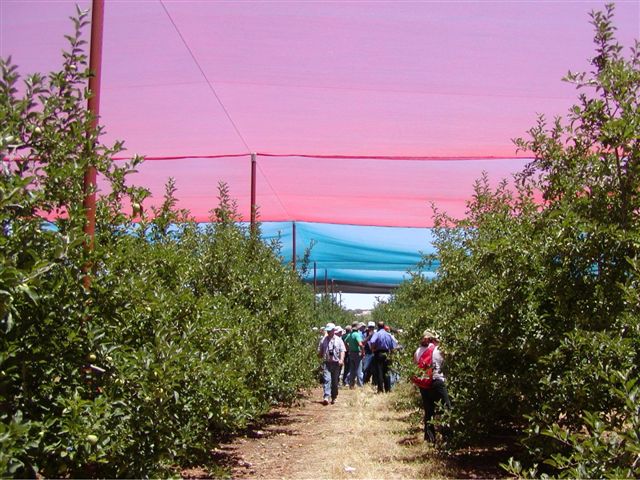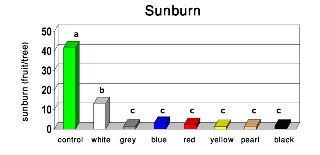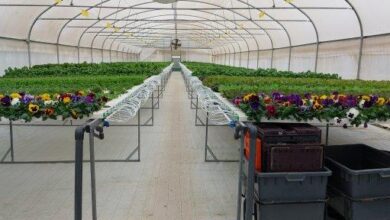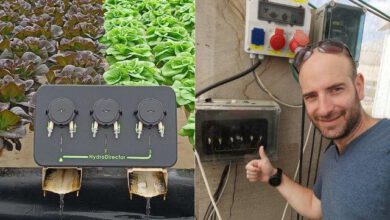Colored Shade Nets for Improved Apple Quality and Yield
Covering apple orchards with suitable nets produces enhanced fruit size and quality

Enhanced apple size and quality, larger high-quality yield, protection against sunburn, effective water consumption, and protection against natural and environmental damage are among few advantages of covering apple orchards with suitable nets.
Research Questions
A. What is the effect of net covering compared with an uncovered orchard?
B. Is the type of net important?
C. What is the effect of selective filtration of solar radiation?
D. Which net properties integrate the most advantages with one covering?
Method
Nets were spread horizontally above the trees in Kibbutz Baram’s apple orchards, in the north of Israel, forming a high and well-ventilated net house.
Varieties: Golden and Starking Delicious
The following nets were studied for five consecutive seasons, in two cycles of 700 m2 for each net: Pearl, Red, Blue, Grey, and Black, with a shading level of 30%, and White with a shading level of 15%.
Control: an uncovered orchard in the same plot
Results
Many advantages were found in covering the apple orchard with net:
§ Protection against natural damage, such as hail and heat waves
§ Creation of a favorable microclimate for deciduous trees: less wind, cooler temperatures and slightly higher humidity
The result: improved assimilation (despite the shading) and reduced water consumption
Distinct differences were found in the effect of the different nets:
§ Pearl: Results indicated significantly higher protection against water stress, larger fruit, higher yield and enhanced quality compared with the other nets. Trees under Pearl net produced an additional 20 tons per hectare of Golden Delicious per year in general yield, with large and high-quality fruit, compared with the uncovered control plot.
§ Red and White: These nets produced second best results in productivity, yield and size for Golden Delicious.
§ Black and Grey: These nets produced the poorest results. Fruit grown under these nets were smaller and yields were lower.
§ All the 30% shade nets provided excellent protection against sunburn, for both varieties, irrespective of the type of net. The 15% shade net provided partial protection.
§ Disadvantages (in some of the varieties): Growth is more vigorous in trees covered by net.
§ There were no negative effects in respect of plant protection or pollinating bees.
Conclusion
§ Covering apple orchards with suitable nets produces a range of advantages with economic value:
Enhanced fruit size and quality, larger high-quality yield, protection against sunburn, effective water consumption and protection against natural and environmental damage.
§ The net properties and selective filtration of solar radiation are extremely important.
§ Nets that diffuse light and are enriched with red spectrum compared with blue and UV (pearl, red and white nets) produce improved results.
§ Nets that do not diffuse light (black and grey nets) produce poorer results.
§ Commercial implementation of the research results is already underway.
§ Directions for further R&D: continued improvement of net properties, adaptation of the technology to other varieties and cultivars, adaptation of irrigation and pruning management to net house conditions, improved plant protection using nets, reduced chemical use
Acknowledgements: With thanks to Polysack for development of the colored nets and the contribution to research.
The research was supported by the Chief Scientist of the Israeli Ministry of Agriculture and Rural Development and the Israeli Fruit Board.
Graphs and photos




Authors & Credits:
Agricultural Research Organization (ARO), Volcani Center, Israel: Yosepha Shahak, Eugene Gussakovsky, Yuval Cohen, Kira Ratner, Yuri Giller, Shabtai Shapchisky, Naftali Tzur
Northern R&D Center, Israel: Rafi Stern, Amos Naor, Shlomi Kfir
Agricultural Extension Service, Ministry of Agriculture and Rural Development, Israel: Yael Greenblat-Avron, Moti Peres, Yisrael Doron,
Baram Orchard, Israel: Rafi Hillel, Yoram Luchti, Gad Ben-Nun
(Published in ISRAEL AGRICULTURE, 2009)




